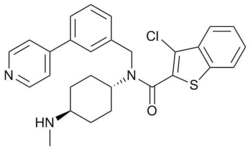Chemistry:Smoothened agonist
 | |
| Identifiers | |
|---|---|
| |
| CAS Number |
|
| PubChem CID | |
| ChemSpider | |
| UNII | |
| ChEBI | |
| Chemical and physical data | |
| Formula | C28H28ClN3OS |
| Molar mass | 490.06 g·mol−1 |
| 3D model (JSmol) | |
| |
| |
Smoothened agonist (SAG) was one of the first small-molecule agonists developed for the protein Smoothened,[1] a key part of the hedgehog signaling pathway, which is involved in brain development as well as having a number of other functions in the body.
Smoothened agonist has been shown to aid proliferation and survival of developing neurons,[2] and prevent drug-induced brain injury.[3] When injected into the cerebellum of newborn mice with an induced Down syndrome-like condition, Smoothened agonist was able to stimulate normal cerebellum development, resulting in significant behavioural improvement once the mice had grown to adulthood.[4]
Smoothened Agonist was capable of inducing androgen production in both prostate and bone stromal cells that was significantly greater than even similarly treated prostate cancer cells.[5]
Some analogues of piperazines as a novel class of Smoothened agonists modulates Hedgehog signaling in the crypts of the small intestines by binding to Smoothened and thereby leading to intestinal stem cell compartment expansion, improved intestinal recovery, and survival of lethally irradiated animals.[6]
References
- ↑ "Reagents for developmental regulation of Hedgehog signaling". Methods 66 (3): 390–397. August 2013. doi:10.1016/j.ymeth.2013.08.022. PMID 23981360.
- ↑ "Smoothened agonist augments proliferation and survival of neural cells". Neurosci. Lett. 482 (2): 81–5. September 2010. doi:10.1016/j.neulet.2010.06.068. PMID 20600593.
- ↑ "A small-molecule smoothened agonist prevents glucocorticoid-induced neonatal cerebellar injury". Sci Transl Med 3 (105): 105ra104. October 2011. doi:10.1126/scitranslmed.3002731. PMID 22013124.
- ↑ "Hedgehog agonist therapy corrects structural and cognitive deficits in a down syndrome mouse model". Sci Transl Med 5 (201): 201ra120. September 2013. doi:10.1126/scitranslmed.3005983. PMID 24005160.
- ↑ "Paracrine Sonic Hedgehog Signaling Contributes Significantly to Acquired Steroidogenesis in the Prostate Tumor Microenvironment". International Journal of Cancer 140 (2): 358–369. 2016. doi:10.1002/ijc.30450. PMID 27672740.
- ↑ Duhachek‐Muggy S.,et al., & Pajonk F. (2019). Radiation Mitigation of the Intestinal Acute Radiation Injury in Mice by 1‐[(4‐Nitrophenyl)Sulfonyl]‐4‐Phenylpiperazine. STEM CELLS Translational Medicine. In press https://doi.org/10.1002/sctm.19-0136
 |

